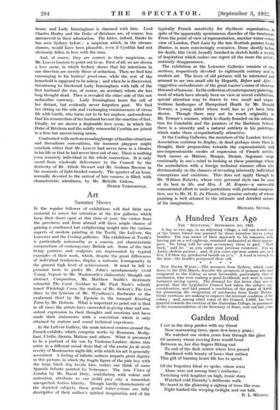Art
Summer Shows
IF the regular follower of exhibitions will find little new material to arrest his attention at the few galleries which keep their doors open at this time of year, the visitor from the provinces and from abroad will have ample chance of gaining a condensed but enlightening insight into the various aspects of modern painting at the Tooth, the Lefevre, the Leicester and the Cooling galleries. The exhibition at Tooth's is particularly noteworthy as a concise, yet characteristic compendium of contemporary British art. Some of the best living painters and sculptors are represented by typical examples of their work, which, despite the great differences of individual tendencies, display a welcome homogeneity in the general high level of achievement. It must be left to personal taste to prefer Mr. John's spontaneously vivid Young Negress to Mr. Wadsworth's elaborately thought out abstract Composition, Mr. Matthew Smith's lusciously colourful The Coral Necklace to Mr. Paul Nash's soberly toned it' hiteleafe Cross, the realism of Mr. Sickert's The Geis Stove to the lyricism of Mr. Wyndham's Backwater or the exuberant Oriel by Mr. Epstein to the tranquil Kneeling Torso by Mr. Dobson. What is important to point out is that in all cases the artists have succeeded in giving clear and con- sistent expression to their thoughts and emotions and have made their statements with a conviction which is only attained by mature and sound technical experience.
At the Lefevre Gallery, the main interest centres around the French exhibits, which comprise works by Rousseau, Modig- liani, Utrillo, Derain, Matisse and others. What is presumed to be a portrait of his son by Toulouse-Lautrec shows this artist in a different mood from that of the exotic fin de siecle revelry of Montmartre night-life, with which his art is generally associated. A feeling of infinite sadness imparts great dignity to this picture, in which the fragile figure of the pale boy with the large black dog beside him, makes one think of some Spanish Infante painted by Velasquez. The two Views of London by Mr. Raoul Dufy, scintillating with colour and animation, attribute to our stolid grey city a somewhat unexpected, festive hilarity. Though hardly characteristic of the depicted subjects, these genial water-colours are fully descriptive of their author's spirited imagination and of his typically French sensitivity for rhythmic organization, in spite of the apparently spontaneous disorder of the treatment. From the point of view of representation, another water-colour view of London, Park Lane by the late Scottish painter Leslie Hunter, is more convincingly evocative. Done shortly before his death, this vivid, broadly brushed-in sketch holds a wealth of inspiration which makes one regret all the more the artist's untimely disappearance.
The exhibition at the Leicester Galleries consists of two sections, respectively devoted to eighteenth century and to modern art. The lover of old pictures will be interested and amused to see two small oils by Hogarth, llifore and After–. suggestive embodiments of the great master's sense of observa- tion and of humour. In the collection of contemporary paintings, most of which have already been on view at recent exhibitions, special attention may be drawn to two small and unpre- tentious landscapes of Hampstead Heath by Mr. Donald Towner, a young artist whose work has as yet been little shown. Though there may not be much originality in Me. Towner's manner, which is clearly founded on his admira- tion for Constable and the painters of the Barbizon School, there is a sincerity and a natural subtlety in his paintings, which make them sympathetically attractive.
At the Cooling Galleries, the members of the London Artists' Association continue to display, in deed perhaps more than in thought, their propensities towards • the expressionistic and neo-impressionistic modes of expression of French artists. Such names as Matisse, Braque, Derain, Segonzac surge continually in one's mind in looking at these paintings where the assimilation with a foreign technical nianner often acts detrimentally on the chances of revealing inherently individual conceptions and emotions. This does not apply though to Mr. William Roberts, whose very personal style can be seen at its best in Mr. and Mrs. J. M. Keynes—a successful concentrated effort to unite portraiture with pictorial composi- tion, nor to Mr. H. E. du Plessis, the genuine naivety of whose painting is well attuned to the intimate and detailed nature of his imagination.
MICHAEL SEVIER.






























 Previous page
Previous page